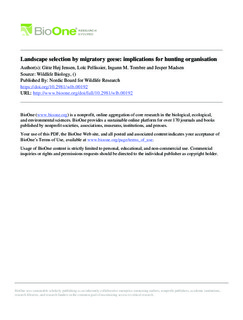| dc.description.abstract | Over the last decades, many wild goose populations have increased significantly and are now causing conflicts with socioeconomic and biological interests. To mitigate impacts of rapid population increases, population control by increasing harvest has been attempted. In this study we seek to guide the design of a regional autumn goose hunting organisation in agricultural landscapes by identifying areas suitable for hunting, which have high probability of occurrence of pink-footed geese Anser brachyrhynchus and/or a short return time by geese to fields subject to hunting. To identify areas suitable for hunting in Nord-Trøndelag County, mid-Norway, we used species distributions models (SDMs), a broadly accepted tool in conservation planning for spatial refuge organisation. The prediction was that the highest probability of goose occurrence exists for large fields, away from small roads and near water bodies serving as safe roosting sites. Additionally, return time was predicted to be shortest for large fields near roosting sites and away from big roads. A combined map of goose occurrence and return time showed similar prediction for high goose occurrence and short return time; hence areas most suitable for hunting are large fields, close to roost sites and away from roads. If hunters and landowners are willing to coordinate goose hunting at a landscape level, they can use the prediction maps as guidance, with the likely benefit that they collectively can shoot more geese. Such local and regional organisation can become a powerful tool in the harvest management of geese. | nb_NO |
